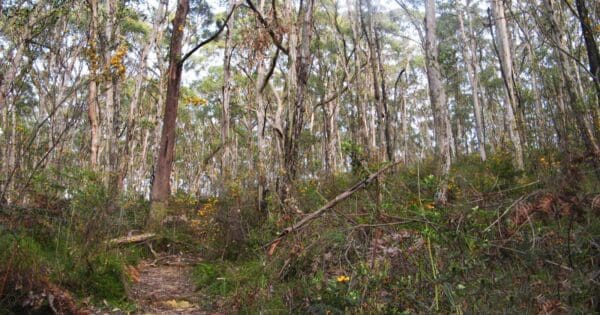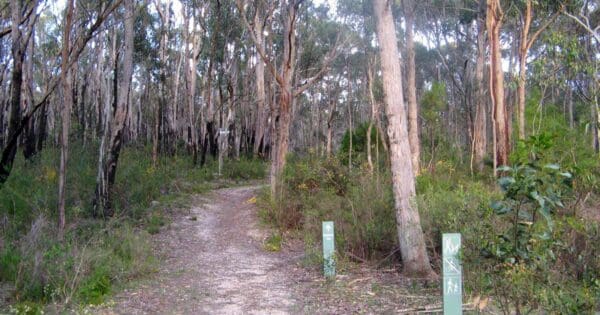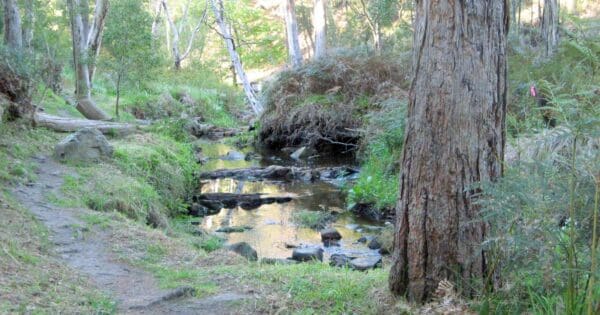Hike at a Glance
Max elevation: 454m
Min elevation: 385m
Total Ascent: 71m
Hike overview
The Waterfall Circuit within Mark Oliphant Conservation Park offers a relatively short but rewarding 1.6-kilometer hike in South Australia. This moderate, 45-minute loop trail takes you on a scenic exploration of a gully, culminating at a seasonal waterfall.
While the park entrance may appear unassuming, don't be discouraged. The park boasts well-marked trails and fire tracks named after streets for easy navigation. Although there's no trail information directly available at the carpark, the park itself offers a beautiful stringybark forest environment.
Begin your hike by heading clockwise from the carpark at Gate 1 on Scott Creek Road. Follow the Thornbill Track for about 70 meters. Take a left onto the fire track named Camp Track. After roughly 500 meters, you'll reach a junction where Camp Track turns uphill to the left. Continue straight here, and within 100 meters, the fire track transitions into a single walking trail. Be aware that the vegetation along this trail might be overgrown at head-height in some sections, but the path itself remains easy to follow.
Tips
- Dogs are not permitted in this park.
- There are no facilities in the park. Please ensure you carry sufficient water, food and supplies for your entire visit.
- It is also a good idea to let a responsible person know of your intended movements and when you expect to return.
- This park is closed on days of Catastrophic Fire Danger and may also be closed on days of Extreme Fire Danger.
Track grade
Grade 3 (Moderate) - Walks for Most Fitness Levels: Grade 3 on the AWTGS represents moderate walking tracks. These are ideal for walkers with some fitness who are comfortable with some hills and uneven terrain. While suitable for most ages, some bushwalking experience is recommended to ensure a safe and enjoyable experience. Tracks may have short, steep hill sections, a rough surface, and many steps. The total distance of a Grade 3 walk can be up to 20 kilometers.
Walk map and GPX file
Max elevation: 454 m
Min elevation: 385 m
Total climbing: 71 m
Total descent: -70 m
Content use
Please don’t copy GPX files or content from this site to AllTrails or other platforms. Each trail has been personally mapped, documented, and refined to support Australia’s bushwalking and hiking community. While some details come from land managers, every listing reflects significant personal effort. This is a free, community-driven initiative—your respect helps keep it that way.
Gallery
Got any photos from this hike? Your photos can help others plan. Share shots from along the trail so fellow hikers know what to expect.
Click to add your photos >>
Getting there
Getting to the trailhead: Mark Oliphant Conservation Park.
The Waterfall Circuit Walk is accessible from Adelaide via the South-Eastern Freeway, approximately 22 kilometers southeast of the city. The hike begins at Gate 1 on Scott Creek Road, which serves as the trailhead for this specific circuit.
Need a rental car to get you to the hike? Find one here.
Find a place to stay
Wondering where to stay near this hike? Find accommodation close to the trailhead — hotels, cabins and campgrounds nearby. Click the button to view the interactive map.
Closest towns to this walk: Burton, Callington, Craigmore, Elizabeth, Green Fields, Mannum, Mawson Lakes, Murray Bridge, Nairne, Oakbank, Palmer, Parafield, Paralowie, Salisbury, Swan Reach, Virginia
Let someone know
Heading out? Fill in a trip intentions form so someone knows your plans. If things go wrong, they can raise the alarm fast, giving you peace of mind on the trail.
About the region
The Mark Oliphant Conservation Park, named after former state Governor Sir Mark Oliphant for his conservation efforts, offers a haven for bushwalkers with its scenic forest landscapes. Keep an eye out for the park's abundant birdlife, including the scarlet robin, golden whistler, and Adelaide rosellas. The park holds particular significance as a critical habitat for the nationally endangered southern brown bandicoot.
Prior to European settlement, the area served as a vital source of food, shelter, and wood for the Kaurna people. It also functioned as a major pathway connecting the hills and plains.
Messmate stringybark and brown stringybark dominate the park's forest canopy. A rare stand of candlebark gums, known for their white bark and limited to high-rainfall regions of the Adelaide Hills, can be found near the oval. Scattered pockets of pink gum, manna gum, and blue gum also contribute to the park's diverse flora. The forest understory boasts a vibrant display of spring-flowering shrubs like myrtle-leaved wattle, beaked hakea, and large-leaved bush-pea. While bushfires in 1980 and 1995 impacted the park's plant life, weeds pose the most significant current threat.
The park provides refuge for elusive creatures such as the southern brown bandicoot and yellow-footed antechinus, alongside various lizard, snake, and frog species. Birdwatchers will delight in spotting the superb fairy-wren, scarlet robin, golden whistler, Adelaide rosella, and numerous honeyeater species. While invertebrates represent the park's most abundant and diverse animal group, their small size makes them less conspicuous. Visitors are encouraged to take a closer look to appreciate the fascinating shapes, colors, and behaviors of ants, beetles, and butterflies.
Similar walks nearby
Looking for more walks in or near Mark Oliphant Conservation Park? Try these trails with a similar difficulty grade.
Explore safe
Plan ahead and hike safely! Carry enough water, pack layers for changing conditions, and bring safety gear like a torch, PLB, and reliable communication device. Check official sources for trail updates, closures, and access requirements, and review local weather and bushfire advice. Most importantly, share your plans with someone before you go. Being prepared makes for a safer and more enjoyable hike! Stay Safe, Explore More, and Always #ExploreSafe.
Packing checklists
What you carry in your pack depends on factors like weather, terrain, and your adventure type. Not sure what to bring? My free planning, food, and packing checklists are a great starting point, covering day hikes, overnight trips, and multi-day adventures. Use them to customise your kit and always prioritise safety.
Suggest an edit
Notice something different about this trail? Whether it’s a new feature, a route change, or a closure, share your update so we can keep our info accurate and helpful for fellow hikers.
Click to suggest edits >>
Acknowledgement of Country
Trail Hiking Australia acknowledges the Traditional Owners of the lands on which we hike and pay respects to their Elders, past and present, and we acknowledge the First Nations people of other communities who may be here today.






